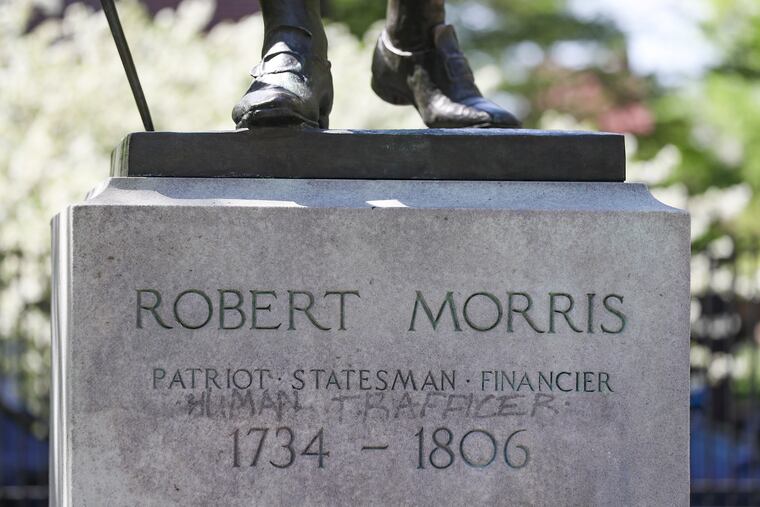Conservationists are having a hard time removing new graffiti on Robert Morris statue that alludes to slavery ties
Morris — who is often called the "financier of the American Revolution" — sold slaves in North Carolina and held auctions before owning a failed plantation in Louisiana.

A statue of Founding Father Robert Morris in Independence National Historical Park will now bear the words “human trafficer” as conservationists struggle to the remove the graffiti.
The misspelled annotation is written on the base of the statue in what appears to be permanent marker, according to an Instagram slide show posted by Independence National Historical Park on Monday.
The statue is behind the Second Bank of the United States at 420 Chestnut St. The use of indelible ink, plus the statue’s base of marble, a porous material, makes the graffiti difficult to remove, the National Park Service said. conservationists tried to delete the markings with nonabrasive chemicals, which only lightened it, the Park Service said.
Then, they moved onto laser treatment that Independence National Historical Park has used previously, which had the same effect.
“Professional conservators within and outside of [the National Park Service] will explore and consider other methods and means to remove the graffiti. Testing of these methods will begin shortly,” the park wrote on Instagram. “INHP will continue to tell comprehensive stories of the nation’s history.”
Vandalizing, destroying, or injuring national park property is a federal crime punishable by up to six months in prison and a $500 fine.
Often called the “financier of the American Revolution,” Morris was a signer of the Declaration of Independence and Constitution who amassed at least a portion of his wealth through the slave trade. Morris, alongside his business partner Thomas Willing, sold about 170 slaves from Ghana in Wilmington, N.C., before pivoting to host slave auctions.
Morris and Willing also briefly owned a 3,000-acre Baton Rouge, La., plantation called Orange Grove, where they oversaw 40 enslaved Africans before the property was expropriated by the Spanish.
Each of these ventures was apparently a money-losing operation, according to a 2005 Inquirer article.
“There is no way that Robert Morris could have taken money from slavery and put it in that bank,” a descendant of the Founding Father told Inquirer reporter Joseph N. DiStefano.
Philadelphia, like much of the United States, began evaluating its monuments — and who they lionize — in the summer of 2020, when the police killing of George Floyd sparked a national movement to topple symbols of systemic racism.
Per a study from Philly-based arts nonprofit Monument Lab, more than half of the 50 historical figures most often depicted in statues were enslavers, including Christopher Columbus, whose Marconi Square statue became the center of a long legal battle after the Philadelphia Historical and Art Commissions voted to remove the statue from Marconi Plaza.
Under Independence National Historical Park’s Instagram post, some commenters were supportive of the graffiti, hoping it would lead to the removal of the Morris statue.
“I’m a tour guide in historic Philly … but even I can’t figure out why we have a statue for him,” wrote one Instagram user. “Surely there are better Philadelphians that deserve statues?”
“Probably shouldn’t have had his statue up in the first place,” wrote another.